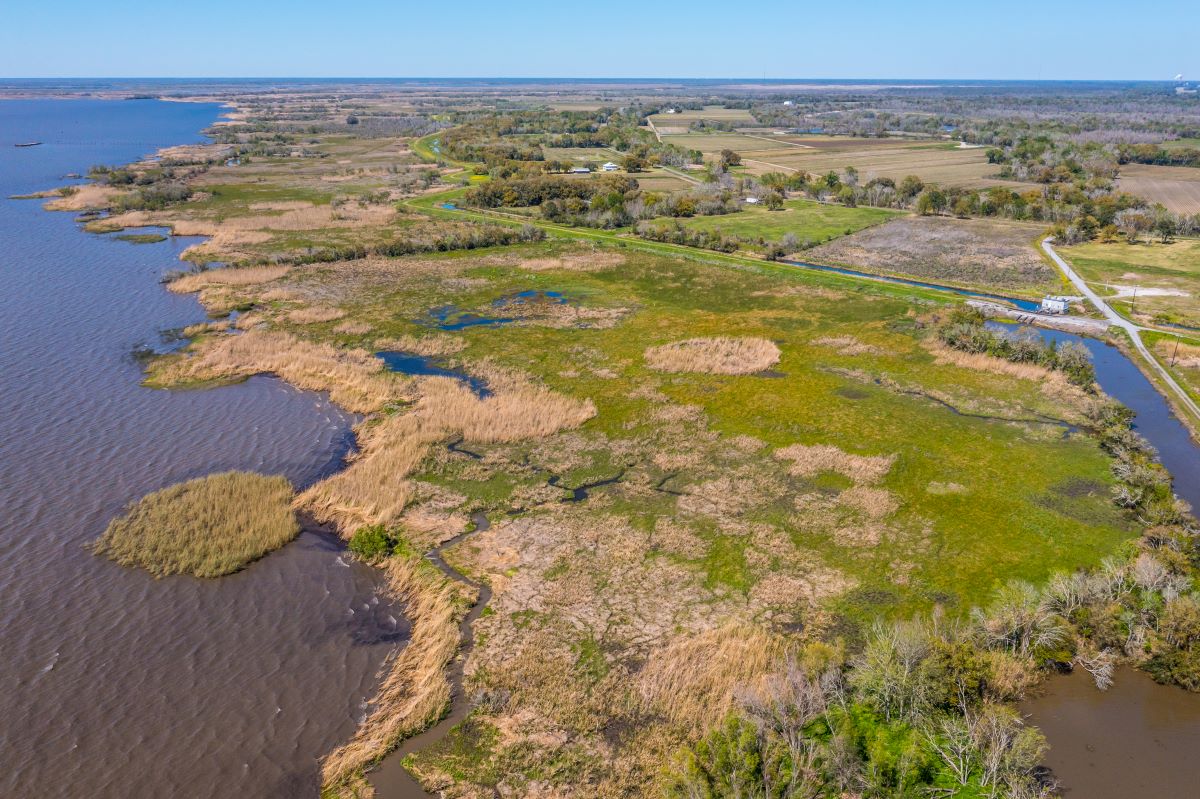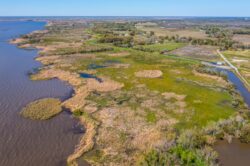Coastal Master Plan
In response to decades of warnings about land loss, Louisiana released its first Coastal Master Plan in 2007.

Louisiana Endowment for the Humanities
West Cote Blanche Bay at Luke Landing in St. Mary Parish. Photo by Zack Smith.
In response to decades of warnings about land loss, Louisiana released its first Coastal Master Plan in 2007. It represented a consolidation of several state programs intended to offset gradual coastal deterioration by restoring wetlands and minimizing the impacts of hurricanes. These dual goals sought to foster a more sustainable environment and economy for the southernmost parishes of the state.
Background
Scientists noted that the Delta was sinking in the late nineteenth century, and deliberate attempts to measure coastal retreat commenced in the 1950s. By 1981 threats to the shorelands had become a prominent concern among scientists, and the Louisiana State Legislature endowed a fund to prepare a comprehensive plan to restore barrier islands and shorelines and divert sediment into the wetlands. Following that action, the Coalition for Coastal Louisiana, a group of academic researchers, environmental activists, politicians, and fishing families, issued a report on the gradual disappearance of the state’s wetlands and proposed steps to redirect river-borne sediment to the sinking marshes.
Louisiana’s Senators John Breaux and J. Bennett Johnston secured federal funding in 1990 to protect and restore the coast. This legislation, oastal Wetlands Planning, Protection, and Restoration Act, supported basic research and the formulation of a planning process to design and implement projects to rebuild barrier islands, redirect sediment to restore wetlands, protect shorelines, and rehabilitate water movement through the coastal region. Dozens of projects have been carried out under the auspices of this precursor to the Coastal Master Plan.
Hurricanes Katrina and Rita in 2005 drove devastating storm surge across sizable areas of Louisiana and made obvious the importance of flood protection for the coastal parishes. This tragedy provided state officials with the motivation and public support to accelerate coastal protection and restoration efforts. The legislature promptly created the Coastal Protection and Restoration Authority (CPRA) and authorized it to consolidate discrete coastal programs of flood control and wetland restoration under a single administrator. The new agency received the mandate to report regularly on its planning and progress to protect and restore the coast. Their first major report, released in 2007, was entitled Louisiana’s Comprehensive Master Plan for a Sustainable Coast.
The Work of the Plan
Launched with unanimous support of the state legislature, CPRA has undertaken an ambitious task. It seeks to deploy the latest science to assess the rate of land loss across the entire breadth of the state, to project the rate and geography of future land loss, and develop and prioritize specific projects to offset land loss and protect coastal communities and economies. The Coastal Master Plan places a clear emphasis on understanding the threat through science and engineering and considers local economic activities, such as oil and gas, transportation, and fishing, in its prioritization process. Public input is solicited as planners carry out the research and design phases of their work. Touted as a 50-year, $50 billion undertaking, the plan is an enormous commitment for the state. Since its first Coastal Master Plan in 2007, CPRA has released subsequent Coastal Master Plans in 2012, 2017, and 2023, with additional Coastal Master Plans scheduled on a six-year cycle. The regular updates permit adaptive management and ongoing assessment of the effectiveness of projects and modification when necessary to improve the projects’ performances and address any emerging problems.
Since its launch, CPRA has assembled over $21 billion dollars from several sources and used those funds to undertake 140 projects that improved over 300 miles of levees, restored barrier islands, diverted sediment to wetlands, and provided benefits to thousands of acres of land from the Pearl to the Sabine River.
Despite its ambitions, the most recent Coastal Master Plan acknowledges that restoring the early twentieth century shoreline is not feasible. Uncertainty about the pace of sea-level rise and land subsidence demands the projection of a range of potential impacts. The 2023 Coastal Master Plan projects that even with implementation of its projects, some 1,100 square miles of land will be lost by the fifty-year mark. Without mitigating projects, that same amount of land would be lost in just thirty-four years. Additionally, without projects, models indicate flood damages would increase by $19 billion a year in the next half century. The agency relies on projected benefits and reduced damages assessments as a means to justify its efforts and expenditures.
Alongside the complex projects being implemented, funding the Coastal Master Plan is a considerable challenge. Although the legislature has consistently provided funds that are cobbled together with a mix of other funds, the state does not have the dollars to cover the estimated costs. A substantial windfall of funds from the 2010 BP oil spill settlement has supplemented the state’s support, but those funds will run out in 2032. Tulane researchers have estimated price increases and inflation could double the cost and leave the state far short of meeting its goal. State officials continue to seek other funding sources.
Through its iterations, CPRA has expanded the opportunity for public input to the plan through forums and advisory bodies. Commonly these public engagements solicit input on options that are already well advanced in their design, and leading industries and professional organizations often dominate the conversations. The number of opportunities for community interaction has not fully addressed concerns of disadvantaged communities. One prominent critique of citizen participation has come from Plaquemines Parish, where residents have voiced opposition to impacts of two major sediment diversions to commercial fisheries.
Louisiana officials tout that the Coastal Master Plan has propelled a new economic engine based in water management and restoration expertise that will drive a prosperous new enterprise. This belief recognizes that other coastal regions will be facing similar issues and will turn to Louisiana for guidance.
